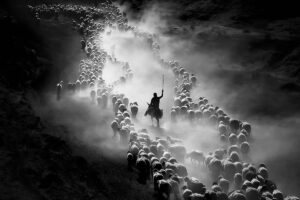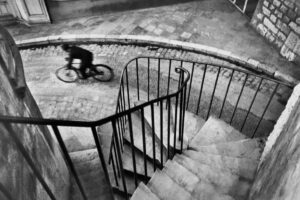“The winds are crazy! That last gust almost knocked me over!” This was the first radio transmission that we heard from Tim. Would we have a chance to photograph Comet C/2023 A3 before it disappeared from view?
Comet C/2023 A3
We were “comet chasing” Comet C/2023 A3, otherwise known as Comet Tsuchinshan–ATLAS in late October 2024. This comet was from the Oort cloud, and was discovered by the Purple Mountain Observatory in China in January 2023. It was also independently found by ATLAS South Africa the following month.
 Using a Nifty Fifty to photograph Comet NEOWISE in 2020. Thankfully, it was not at all windy on this day!
Using a Nifty Fifty to photograph Comet NEOWISE in 2020. Thankfully, it was not at all windy on this day!In Southern California, it was big and bright, noticeably brighter than Comet NEOWISE, which I photographed by the radio telescopes in Owens Valley earlier. We wanted to photograph it over picturesque Convict Lake.
But the howling winds of the Sierra Nevadas had other ideas.
Arriving at Convict Lake
You know it’s windy when you are concerned that the winds whipping at your car door while it’s opening may damage it.
Tim hopped out first. He grabbed his tripod and, head down, made his way from the parking area to the lake.
Suddenly, an absurdly powerful gust of wind, even worse than before, ripped at our clothing. A minute later, our radios crackled with his voice: “The winds are crazy! That last gust almost knocked me over!”
Later, George’s lens cap flew away. Somehow, we actually found it.
Still, we decided to stay and photograph.
Why photograph in such crazy weather?
The other lakes and areas were also extremely windy. And if we drove over there, we would likely miss the comet, which was dropping fast. If we waited much longer, it would drop behind the Sierra Nevadas, out of sight of our eyes and our cameras. We decided to stay.
Kneeling on the dock of the bay
I set up my camera. This was easier said than done, as I had to keep wrapping my legs around the tripod to stop it from flying away. I finally got the camera and intervalometer attached.
I decided that since it was very dark, I would still reel off 25 successive photos of the Milky Way so I could stack it later in Starry Landscape Stacker. This would lower the noise.
I knelt on the dock of the bay. My idea was to kneel by my camera and hold it down for the entire sequence. I was photographing 15-second exposures. Since I was photographing them 25 times, this would be 3.75 minutes. That’s 3.75 minutes of gale-force winds.
Look! Up in the sky! It’s a bird! It’s a plane! It’s an intervalometer!
Right before I was about to begin my sequence, my intervalometer flew off the tripod!
It had been attached by hook-and-loop fasteners; basically, industrial-strength Velcro. It had never fallen off my tripod before unless I hit it really hard. But here, the wind ripped it from the tripod and sent it flying across the dock, where I was kneeling. I had to lay the entire tripod down, retrieve my intervalometer, and set everything up again.
Click! Click! Click! Click!
While kneeling in front of my camera, I could hear waves crashing against the dock, and the wind going from very windy to gale-force winds, ripping at my jacket. I held the tripod down with both arms, driving it into the dock as hard as possible. Finally, my 25-photo sequence stopped. I happily grabbed the tripod and made my way behind a bank of trees that somewhat blocked the wind.
How do you process a photo from shaky photos?
I began stacking the photo in Starry Landscape Stacker.
The idea here is to take several photos, one right after another, to reduce digital noise that generally occurs when pushing the camera’s sensitivity higher and higher. The app will perform its mathematics magic to make life easy for you. It will identify the stars on each of your images, align them, and then stack them.
This works great if your camera is still. That had never been an issue before. And I was holding the tripod down with great force.
Nonetheless, a lot of my photos came out with slightly crooked, misaligned stars. I began realizing that all of the ones that did this were because the dock itself was vibrating from the pounding waves and wind.
Still, I managed to salvage this photo by taking some of the middle photos. Only a few of them were misaligned, so I tossed them both at the beginning and end of the sequence.
That horizon is really crooked!
When I went to set up my tripod again after the intervalometer flew off, I forgot to straighten the camera for the horizon. It was dark, so I didn’t notice that the horizon was very crooked. And in all the chaos, it simply slipped my mind. I was more concerned with getting through the process.
When I reviewed the individual photos, I was dismayed to discover how crooked the horizon actually was.
Thankfully, there was enough “information” on the photo that I could afford to straighten the horizon. I filled in some of the corners using Generative Expand in Photoshop. This uses artificial intelligence (AI) to expand an image’s size and fill in empty space with new content. Since it was the corners only, Generative Expand produced content that was indistinguishable from the original photo. I can’t even tell where my photo ends and Generative Expand begins because those parts are almost identical to the original, albeit crooked photo.
Serenity vs. chaos
When you view the photo, it looks serene. The settings were anything but that. But there’s that odd disconnect. We as photographers usually try to capture the feel and emotion of what we are photographing. This is one particular case where it’s probably a good thing that I didn’t.
At least we have an amazing story to tell.
 C/2023 A3 (Tsuchinshan–ATLAS) at Mobius Arch in Owens Valley, CA, with the Sierra Nevadas in the distance.
C/2023 A3 (Tsuchinshan–ATLAS) at Mobius Arch in Owens Valley, CA, with the Sierra Nevadas in the distance.What a difference a day makes. This was photographed during a very calm evening just 24 hours earlier!
A note about my photography mates
Yes, they both survived.
Tim Little and I teach night photography workshops.
- Nelson Ghost Town and Goffs Night Photography Adventure: April 10, 11 and 12, 2025
- Joshua Tree/Borrego Springs Night Photography Adventure: June 21 -26, 2025
- Nelson Ghost Town (Dark Skies) and Goffs Night Photography Adventure: October 16-19 2025
George Loo is the developer of the ProtoMachines, a handheld light specifically designed for light painting. It’s generally considered the Rolls Royce of light painting devices.

 1 week ago
41
1 week ago
41







 English (US) ·
English (US) ·